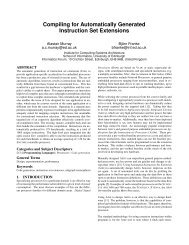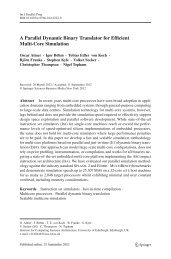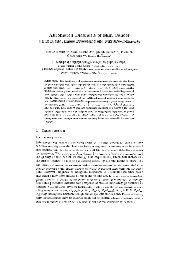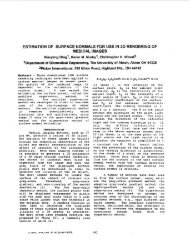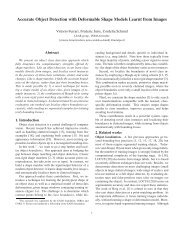WebExp2 Experimenter's Manual - School of Informatics - University ...
WebExp2 Experimenter's Manual - School of Informatics - University ...
WebExp2 Experimenter's Manual - School of Informatics - University ...
Create successful ePaper yourself
Turn your PDF publications into a flip-book with our unique Google optimized e-Paper software.
Defining your own behaviour for the stage If you want to get a different combination <strong>of</strong> behaviours, you<br />
can specify the behavioural properties individually instead <strong>of</strong> specifying a type. Any options you want to use<br />
should just be included as an empty tag — the options are listed in figure 9.<br />
Note that if you include any <strong>of</strong> these tags in addition to a tag, they will override any settings from the<br />
type. If no tag is included, then the three options are set to false and overridden by whichever options<br />
you include.<br />
Collecting Subject details The stage type subject is provided for you to collect information which is not<br />
directly related to the experiment. The usual application <strong>of</strong> this will be to provide a stage near the beginning<br />
<strong>of</strong> the experiment in which you request details about the participant (subject) <strong>of</strong> the experiment. This will<br />
resemble a questionnaire. Details are recorded with the results.<br />
5.5.4 Templates<br />
An important concept in defining your stages is that <strong>of</strong> a template. There are two ways <strong>of</strong> constructing the<br />
sequence <strong>of</strong> slides in a stage:<br />
1. explicitly describe each slide<br />
2. describe one or more template slides along with a repetitions parameter<br />
If you use the first option, you can just write a sequence <strong>of</strong> slides which are shown in the order you describe<br />
them (unless you specify an ordering or randomisation). You can also use the variables feature <strong>of</strong> slides.<br />
Using the second option is very easy – you write your slides in the same way, but this sequence is used as a<br />
template, and is duplicated a number <strong>of</strong> times. The sequence numbers for slides are automatically generated.<br />
Repetitions For a stage where the same slide (or sequence <strong>of</strong> slides) is shown repeatedly with different<br />
contents, the stage needs only contain one slide (or a sequence), along with a tag such as<br />
5. The changeable components within a slide should also have an tag<br />
which identifies a particular resource set from which resources will be imported. The sequence <strong>of</strong> one or more<br />
slides will be repeated the specified number <strong>of</strong> times, with resources being imported each time from the resource<br />
set specified in the import tag.<br />
Note: It is up to you to ensure that your resource sets contain enough resources to fulfil all the imports in your<br />
repeated template. If there are too few, nothing will be imported. Additionally, if you define one <strong>of</strong> the following<br />
stage reorderings, they will be applied to the sequence <strong>of</strong> slides which are generated from your templates and<br />
resource imports. In some cases this may have no practical application – usually you will want to randomise<br />
either your imported resource sets, or the slides in your stage.<br />
5.5.5 Hard stage orderings<br />
The first way to specify a reordering <strong>of</strong> the slides in the experiment description file is to specify an tag<br />
in the stage. This ordering, if valid, will be used for this stage unless overridden by a proper randomisation.<br />
An ordering is specified as a comma-separated list <strong>of</strong> integers; for a stage with n slides, this should be a list <strong>of</strong><br />
the numbers 1 to n. However you can also leave numbers out, to provide a subsequence <strong>of</strong> the stage’s slides.<br />
Thus an ordering for a 7-slide stage could look like this: 5,6,2,1, 3, 7. Note that you can<br />
use whitespace in the list if it makes it more readable.<br />
Note: If you have generated a stage from a template, you will have to take this into consideration if you decide<br />
to define a hard ordering.<br />
31



